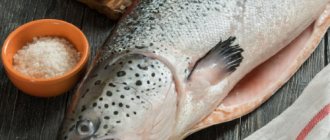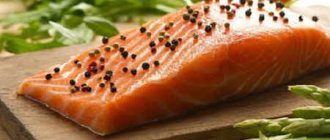Fish on a coat
First of all, try a piece. If the salt is very strong, then you will have to save the situation as follows. Cut the fish into pieces and sprinkle with lemon juice. You can add a little pepper. Now set the fish aside temporarily. Today we will look at several options for what to do if the fish is over-salted, among which you can choose the one you like best.
So, the fish is soaked in juice, and we prepare the vegetables. Fry a fairly large amount of onions and carrots in vegetable oil. You don't need to salt the vegetables to compensate for the excess salt in the fish. Pour lemon juice over the vegetables and add a little sugar. You can also sprinkle the fish with a little sugar. Now place vegetables and fish in layers in a saucepan, then heat for 5 minutes. Vegetables will remove excess salt.
Video recipe for lightly salted herring at home
I suggest watching a video where the author salts fish, and most importantly explains everything in detail. This recipe shows how to quickly dutch pickle with regular apple juice from a carton. By the way, to be honest I have never done this myself. I was just looking for new recipes and came across this by accident. And so I decided to share with you. So guys, if anyone makes this option, tell me in the comments how it turned out. Although if you believe the author, it turns out very tasty. But try anyway.
These are the interesting ways of lightly salted herring that were told and shown today. I hope I didn't miss anything. These options produce very tasty fish. Therefore, you can safely treat all your family and friends to it. And I say goodbye to you, see you soon!
National dish of Latvia
Herring with milk is the national dish of Latvia, called silkumaizee.
Step-by-step cooking recipe:
- Peel the herring, cut the fillets into small slices and pour in the milk.
- Add a tablespoon of vegetable oil and mustard powder, chopped dill.
- Cut the rye bread into slices and place in the oven.
- Then apply a layer of butter, and put the herring mass and cut sausage on top.
- Bake until the fish is done. The time depends on the number of products taken.
Mash the boiled eggs with a fork and add to the mixture, mix well.
Jewish herring
Forshmak in Odessa is the simplest Jewish recipe, which has deservedly become a national dish. Russian housewives like to prepare this dish. The recipe will not take much time, and you will also need affordable ingredients. It is impossible to over-salt the dish, even if the herring is very salty. A bun soaked in milk adds juiciness and neutralizes the salt, while vinegar and butter add a piquant flavor to the finished product.
Required:
- 500 g fish fillet;
- 1/2 cup milk;
- 4 slices of loaf;
- 3 eggs;
- 2 tsp. mustard;
- 2 tsp. vinegar;
- 1 onion;
- 60 ml oil.
Step-by-step recipe with photos:
- Place the loaf in milk to soften.
- Separate the yolk and grind with mustard, add a little oil.
- Grind the onion, fillet, whites and loaf, mix everything and mix with the yolk, pour in the oil and vinegar.
Of course, this is a simplified version of Jewish forshmak, but it’s easy to prepare, spread on a piece of bread and have a snack.
Adviсe
You need to pour fresh milk over the fish; there is no need to boil it.
- Spicy salted fish, fatty, Atlantic and smoked herring are not soaked.
- To save milk, it is diluted with water in the same proportion and poured into the fish.
- You can also use other dairy products, such as whey, kefir, and yogurt.
- If the fish fillet is too soft, you can add vegetable oil to the herring. Place the pieces in a container and pour in oil to cover completely. Place in the refrigerator for a couple of days.
- Onions will help improve taste. Peel the vegetable, cut into half rings, add sugar, salt, vinegar and mash with your hands, then let stand for 10 minutes and add pieces of fish. Onions add a delicious flavor.
In creamy sauce
And we continue to look for options on what to do if the fish is over-salted. For the option when the excess salt is not too significant, this method is suitable. All pieces need to be placed in a saucepan. Now fill them with milk, cream or sour cream. Simmer a little. The sauce will remove excess salt, and the fish will be in a creamy sauce. What to do if the fish is significantly over-salted? The sauce can also save the day. To do this, you just need to add a little more dairy product. Then you will end up with a lot of liquid sauce, which can easily be corrected with a spoonful of flour. Flour also tends to absorb salt, so the fish will quickly taste normal. The main thing is not to simmer for a long time so that it doesn’t taste boiled.
Soaking in tea or milk
- strong tea
- sugar
- milk
- salted herring
In the old days, herring was salted very heavily so that it could be stored longer, and was soaked before eating in strong sweet tea or fresh, unboiled milk. This significantly affects the final quality of the product and adds a sweetish or milky taste to the herring. So, cut the fish along the back into two parts. There is no need to remove the skin. Immerse it completely in cooled tea with sugar or milk. Tea, thanks to tannins, will prevent the pulp from becoming soggy and blurry, and milk, on the contrary, will give the herring tenderness and airiness.
Salty fish
When a novice housewife starts salting food, she, too, often faces difficulties. If you added a little salt to the marinade or exceeded the permissible soaking time, the product is impossible to eat. What to do if you oversalt the fish when salting? The main thing is not to panic. Fish is a delicate product, and its tissues are quickly saturated with salt. But it can just as easily be washed back. To do this, just immerse it in a bowl of clean water for a day. After this, you can safely start cutting and preparing fish for dinner.
Dry salted herring: very tasty
The herring carcass is kept in cold water for about an hour. After this, the fish is cut. The head is cut off from the carcass and the giblets are removed, after which the fish is additionally washed and thoroughly wiped with a paper towel.
Take 2 tablespoons of salt and 1 tablespoon of sugar and mix. The fish is rubbed on all sides and wrapped in three layers of cling film. After this, the herring is left in this state for 2 hours. After this time, the fish is unwrapped, washed with water and dried with a towel. Finally, the herring is placed in a bowl and topped with onions, and also filled with sunflower oil. After half an hour, the herring can be eaten.
Dry-salted herring - Treat the Middle - Evgenia Kovalets - episode 83
What kind of pressure is needed when salting herring?
There is no need for oppression. Even in production conditions, when fish is salted in barrels, pressure is selected in such a way that it only slightly submerges the fish in the brine and does not allow it to float to the surface and come into contact with air. At the same time, the oppression should not squeeze the fish. The more spacious it feels in the brine, the more uniform the access of the brine and the faster and more uniform the salting process itself. And vice versa, when the fish is packed tightly and when it is strongly compressed under pressure, places are formed where there is practically no access to the brine. Salting out occurs unevenly. At home, if you salt fish in a spacious bowl using wet salting, just press it lightly. For example, you can put a plate on top, and put a small weight on the plate in the form of a can of water.
Why do you need to soak herring?
For a long time, fish was very well and abundantly salted for long-term storage. Before use, it was poured with water, tea, and milk to get rid of excess salt and improve the taste. The old recipe is still used today. Milk makes the meat more tender, and strong tea makes it stronger; thanks to the tanning components, the product does not spread or fall apart when cut.
Herring is devoid of carbohydrates and is allowed as part of a diet. But salt is harmful to the body and is excluded from nutrition in most diets. Therefore, for many people, overly salted herring is contraindicated for dietary purposes or it requires soaking.
When purchasing fish made in production conditions, its degree of salting can be found on the packaging:
- 9% – light salting;
- 9-14% – medium salted;
- 14% or more – strongly salted.
Fresh milk is not used with herring, but it is often used in cooking, for example, when baking fish. Soaking herring in milk to remove excess salt will be correct and not harmful to health. There are many recipes for cooking herring with sour cream, mayonnaise, and milk brine.
The simplest and cheapest option is to soak the whole fish in plain water for an hour to two days. For 1 kg you will need 3 liters of liquid, which must be changed every 3 hours. As a result, the fish will become softer and less salty. You can also pour for 2 minutes. herring with hot water and then immediately put into cold water. But this method deprives the product of fat content. This is what you do with lean fish. Herring absorbs different aromas well, and adding vinegar and onions to the water or before soaking will help get rid of foreign odors.
As an additional saving, you can not throw away the insides, but prepare an interesting dish from the milk.
In milk
Milk will help reduce the saltiness, as it absorbs salt and makes the meat white. The herring turns out juicy with a delicate texture. For 1 kg you will need 250 ml of milk. The carcass is first cleaned, cut into fillets, placed in a bowl and filled with milk, which is changed every 3 hours. The container is placed in a cold place.
In vinegar
Prepare the marinade: 1 tbsp. l. vinegar per 1 liter of water. Soak the fish in the resulting mixture for 6 hours, or more if necessary. Acid removes unpleasant odor and makes meat tastier.
In tea
Prepare tea without any additives. Take 1 tsp per 100 ml. Sahara. When the solution has cooled, pour over the fish and leave for 4 hours. Tanning components will not only get rid of salt, but also add a yellowish color and a pleasant aroma.
What to do with over-salted herring?
Leave in the refrigerator for an hour or two (depending on the saltiness).
Through the incision made, you should remove the caviar from the belly of the fish if it is of interest to you. You will have to separate the herring meat from the spine with your hands and a knife. Usually the meat is separated from the bones quite easily; to remove the smallest and thinnest bones stuck in the meat, you can use ordinary tweezers.
Sometimes you don’t have enough patience, sometimes there is no one nearby who can support and advise. The portal was created to help you change your life in the direction that is more attractive to you. Thick-backed herring will be much tastier than its slimmer counterparts. Fish with a thick “belly” often contain caviar or milt. First of all, the fish must be gutted, removing all the insides.
Fish, regardless of the method of its preparation, is a storehouse of useful substances for the human body.
First, you need to determine what it will taste like. It's simple. When serving, sprinkle with chopped egg and dill. Cut the herring into cubes. Decorate the top with a mesh of mayonnaise, beet roses and carrot leaves. 2 herring fillets.
At home and on the go, you can get some fresh water with the help of improvised means. However, it is difficult to obtain large amounts of fresh water using this method, because when you remove the lid, a huge part of the drops will flow back into the pan. It is possible to improve this desalination plant. When cooled, fresh water freezes faster than salt water.
How to choose fish for salting
This question is the main one, since the taste of the finished fish will depend on the quality and freshness of the main ingredient.
Usually, frozen or chilled fish is used for salting. It is very important to know the basic rules for choosing the most delicious fish.
When purchasing chilled herring, pay attention to the following:
- For salting, it is best to take whole, not gutted carcasses with the head on.
- The skin of the fish should be smooth, even, shiny, without damage or dark spots. The only exception is the dark stripes on the dorsal part of the carcass, characteristic of this type of fish.
- The eyes of chilled fish should be clean, without white coating.
- When you press on the carcass with your finger, there should be no marks or dents on the skin.
- For salting, it is better to take the largest and thickest herring. This fish is much fattier and more flavorful.
- When purchasing a carcass with a thick belly, there is a high probability that there will be caviar inside, and this is also a delicacy.
The rules for choosing frozen fish are slightly different:
- Herring carcasses must be intact, without damage to the skin.
- Pay attention to the amount of ice; there should be a minimum amount.
- Under no circumstances should there be any yellow spots or stains on the surface of the fish.
- The smell of fish should not raise suspicions about a low-quality product.
What to do with over-salted herring
Or you bought over-salted fish in a store and were upset, and are even going to take it back, demanding back the money you paid for it: you shouldn’t do this. We clean the fish from all the bones. There should be just a little vinegar so that the water is only acidified. Add a drop of vinegar to the last water. And believe me, no one will even say that it was hopelessly oversalted. You can decorate the top with a bow.
You will simply sharply reduce its shelf life, and the amount of salt that will be lost is minuscule. It has been verified. This is just a deception - an UNPROFESSIONAL trick from SMART GUYS. The herring will take up salt in 3-4 days - no more and no less. In our house we really love herring, I generally love any salted fish, but that’s a separate topic. So, I quite often salt the herring myself. Ninotchka! I wrote that we are “Starting a series of simple homemade recipes and tips.” Anyway, THANK YOU for the recipe. It can be tricky... The entire Internet is teeming with recipe options. And then I read somewhere that the upper fin of pike perch is poisonous, so I prepared aspic for Shrovetide. Then almost every apartment will smell of fried herring. But the herring is very tasty, lightly salted, and I never add salt to it, I just rinse it of brine and clean it. But I will definitely take your advice!
In this case, housewives are looking for information on how to eliminate such a problem. To make the search easier for our readers, we will try to group information on how and in what composition to soak herring in a table. This “reanimation” method is suitable for both whole fish and already cut herring. It is used if the herring needs to be served to the table within a short time.
In this case, it is not difficult to distinguish fish of different salting even at first glance, and to do this you just need to evaluate the color of the eyes and gills of the salted product. Unscrupulous sellers resort to such techniques as gutting the fish and then selling the filleted herring. The liquid should smell like salted fish, and the latter should not come into contact with air (that is, it should be completely covered with water). Even in one bucket there may be fish of varying degrees of saltiness.
How to properly soak herring from salt in water: recipe
To remove excess salt from fish, immerse it in liquid for a certain time. In this option there will be ordinary water. This method is considered the simplest and most convenient. When a salted herring is immersed in water, diffusion of salt occurs from the very beginning, which passes from the fish's body into the liquid.
You can speed up this process by using the following methods:
- If possible, increase the surface area of the liquid that the herring will come into contact with.
- Soak the fish in this way - the concentration difference formed between the herring and water should be increased
What do these two methods mean? Let's try to figure it out:
- To fulfill the first requirement, clean and gut the herring before soaking
- To comply with the second requirement, change the water with herring as often as possible
The fish is soaked in both running and changing water.
Soaking herring in water
Soak in running water:
- To soak in running water, gut the herring, place it on a wire rack, and immerse it in a container filled with water. Make sure there is space between the bottom of the pan and the wire rack. Water should flow into this space through a tube.
- Over time, the water will begin to rise upward, washing the herring and flowing out of the container. Therefore, place the container with fish in the sink. Soaking using this method will take you approximately 6 hours.
Soaking in changing water:
This option is considered simpler and more accessible. To use it, do the following:
- Fill the prepared herring with cool water in the following calculation: 2 liters of water/1 kg of salted herring. Take cool water so that its temperature is no more than 12 degrees Celsius.
- Don't change the water very often. First do this after an hour, then after 2 or 3 hours.
In extreme heat, make sure the liquid is always cool. In order to cool it faster, you can use pieces of lude.
As you noticed, soaking salted herring in water is not a very exciting task. But you can also use other methods. Choose at your own discretion.
Forshmak from soaked herring
Herring (65 g), potatoes (140 g), 1/3 egg, sour cream (10 g), butter (10 g), cheese (15 g). Peel the herring (remove the skin, remove the backbone and bones), then soak. Soaking: for 8-10 hours, periodically changing the water (you can also soak the herring in milk). Boil the potatoes. Pass the herring and potatoes through a meat grinder. Then add the egg and sour cream. Beat well. Place the resulting mass in a greased frying pan, level it, sprinkle with grated cheese and bake in the oven.
Composition and nutritional value
The main nutritional components of herring are proteins (about 20%) and fats (100 g of fillet contains from 8 to 18 g). A medium-sized herring includes the daily protein requirement for an adult.
Nutritionists consider boiled, baked and lightly salted herring healthy. Calorie content depends on the type, time of catch, size of fish and cooking method. Boiled herring has the fewest calories (120–130 units per 100 g). Marinated fish contains 150-160 units, hot smoked fish - 210-220 units, salted fish - 240-260 units, fried fish - 250-270 units.
What are the benefits of herring
Herring is suitable for feeding children over 1.5 years of age and adults; its nutritional value has been confirmed by research in scientific laboratories. The chemical composition is rich in vital micro- and macroelements that have a healing effect on the body.
Healthy fish contains a lot of vitamin D, which is necessary for the prevention of rickets in children. Vitamin D:
- helps strengthen bone tissue in osteoporosis;
- accelerates healing after injuries;
- helps restore nerve cells;
- normalizes the functioning of the thyroid gland.
Omega-3 unsaturated fatty acids:
- have a positive effect on the functioning of the cardiovascular system;
- improve brain activity;
- strengthen the immune system;
- have rejuvenating properties.
Doctors recommend consuming fatty fish to prevent the development of atherosclerosis, diabetes, rheumatoid arthritis and cancer.
Omega-3 is a remedy that strengthens the reproductive functions of the male and female body, as well as supports health during menopause. A complex of minerals and vitamins helps improve the condition of skin, hair and nails.











